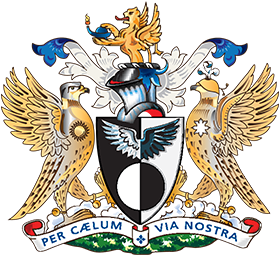- Home
- What we do
- News and Comment
- Scholarships
- International Air Pilots
- +44 (0) 20 7404 4032
- Member Login
The Hugh Gordon-Burge Memorial Award
Awarded to a member or members of a crew whose outstanding behaviour and action contributed to the saving of their aircraft or passengers.
2023 awarded to: David Barrell
On Saturday 4 September 2021, David Barrell was the formation lead pilot for the AeroSuperBatics wing-walking display team and suffered a partial engine failure mid display at the Bournemouth Air Festival. An engine failure being even more of a concern for display pilots due to the low heights at which displays are flown, this situation was further complicated by performing formation aerobatics over water. The problem first manifested itself whilst inverted performing a formation loop.
David first started display flying in 1999 and joined AeroSuperBatics in 2006 and has completed well over 1300 displays (not counting practice displays). This experience and the well planned and rehearsed procedures used by AeroSuperBatics, together with David’s calmness under pressure, led to a textbook handling of a difficult situation.
 David immediately terminated the display and informed the Flying Display Director by radio of a partial power loss. He also signalled the wing-walker to get down from the rig and secure herself in the front cockpit and remove the safety tether, in readiness to evacuate the aircraft. The number two aircraft was also instructed to move further out in case David needed to make an abrupt manoeuvrer or suffered control difficulties.
David immediately terminated the display and informed the Flying Display Director by radio of a partial power loss. He also signalled the wing-walker to get down from the rig and secure herself in the front cockpit and remove the safety tether, in readiness to evacuate the aircraft. The number two aircraft was also instructed to move further out in case David needed to make an abrupt manoeuvrer or suffered control difficulties.
During this time David continued to evaluate the state of the aircraft, which was still producing power, albeit reduced but sufficient to maintain height. Options were considered whether to ditch in the sterile display area on the water, or attempt to make it back to the airport, or an off-field landing. A prime consideration was not to overfly the spectators or built-up areas. David considered that a route to the west along the coast and into the Poole harbour entrance would ensure no risk to those on the ground and potentially enable a return for a safe landing.
However, the engine continued to lose power and approaching the harbour entrance, it became clear they would have to ditch. David continued to assess the safety of others and selected a touch down point out of the boating lanes and away from the chain ferry but close to land and potential rescue assistance. He carried out a well-judged ditching at minimum speed in a tail down attitude, but despite this, the aircraft flipped over on impact. David evacuated the aircraft and continued to look after the wing-walker, who was in a state of shock and needed assistance to vacate the inverted and submerged aircraft.
Assistance was soon on hand from a small inflatable dinghy which was first on scene and only had space for the wing-walker on board The rescuer remarked at David’s calmness when he said he would hold on to the side whilst they towed him to shore. Both were taken to hospital with minor injuries and discharged later that day.
The professionalism with which the incident was handled continued with the post incident analysis aided by the AAIB report, which confirmed how well the incident was handled and the planning for such an incident. The SOPs and regular rehearsal briefings were found very complete, and it was decided by the team to add some extra hand signals for crew communication. Analysis of the mechanical failure which caused the total loss of engine oil and the subsequent engine failure, led to inspection of other display aircraft and engineering changes made to address the potential weakness.
David Barrell’s outstanding behaviour and action on this occasion contributed directly to the saving of his passenger and potentially others, and he is accordingly awarded the Hugh Gordon-Burge Memorial Award.
Previous Winners:
1974/75 G W Crawford Esq
1976 - 1978 not awarded
1978/79 Captain F H Benton
1980 - 1981 not awarded
1981/82 Captain E H J Moody
1983 - 1986 not awarded
1986/87 Captain Peter Saxton
1987/88 Captain Shornsteimer
1988/89 Captain Dave Cronin
1989/90 FO A Atchinson Purser J Heward Stewardess S Prince Steward N Ogden Steward S Rodgers
1990/91 Captain Alfred L Haynes
1992 not awarded
1992/93 Captain I Berglund FO M Emery Flt. Engineer T N Boone
1994 not awarded
1994/95 Flt Lt A J Stacey AFC RAF
1995/96 Crew of G-TIGK - Captain C J Roberts Senior First Oficer L J Sole
1996/97 Captain Leul Abate
1998 not awarded
1998/99 Flt Lt Geoffrey Sheppard AFC and Flt Lt Ian Brosch MA BSc
2000 not awarded
2000/01 Captain Bill Hagan and SFO Philip Watson
2002 not awarded
2002/03 Lt Cdr Neale Hargreaves MBE - Mission Commander of Dolphin 43
2003/04 Captain Eric Gennotte, FO Steeve Michielsen, FE Mario Rofail
2004/05 Captain Mark William Hoey
2005/06 Thierry Fautrel & Marie-Pascale Bulle of Air France AF 358 at Toronto Airport
2006/07 Kevin (George) Francis
2008 not awarded
2008/09 Ultimate 21 Flight in Afghanistan
2009/10 Flt Lt Alex Townsend RAF
2010/11 Crew of Flight QF 032 (AIRBUS 380 VH-OQA)
2011/12 Flt Lt N McCready BEng RAF and Flt Lt L D Flemington DFC MSc BAv RAF
2012/13 Lt Bryan Peterson USN
2013/14 Captain Malcolm Waters and First Officer David Hayhoe
2014/15 "Ugly 52" - Maj Nicholas George English AAC and Capt Charles William Russell AAC
2016 Captain Richard Alvarez
2017 Flt Lt Karl A Kinsler RAF
2018 Flt Lt Ben Wallis AFC RAF
2019 not awarded
2020 Flt Lt Paul Medford RAF
2021 Crew of TALON 42
2022 Crew of Air Astana Embraer 190
2023 David Barrell
- Company Objectives
- Professional Committees & Technical Groups
- Instructional Guides
-
Trophies & Awards
- The Trophies & Awards Committee
- Call for Nominations
- Terms of Reference for Awards
-
Award Winners
- The Award of Honour
- The Grand Master's Award
- The Master's Commendation
- The Master's Medal
- The Hugh Gordon-Burge Memorial Award
- The Prince Philip Helicopter Rescue Award
- The Barry Marsden Memorial Award
- The Sir Barnes Wallis Medal
- The Grand Master's Medal
- The Brackley Memorial Trophy
- The Johnston Memorial Trophy
- The Sword of Honour
- The Myles Bickerton Trophy
- The Hanna Trophy
- The Derry & Richards Memorial Medal
- The Eric 'Winkle' Brown Memorial Award
- The Sir James Martin Award
- The Cumberbatch Trophy
- The Glover Trophy
- The Central Flying School Trophy
- The Pike Trophy
- The John Landymore Trophy
- The Sir Alan Cobham Memorial Award
- The Grand Master's Australian Medal
- The Australian Bicentennial Award
- The Captain John Ashton Memorial Award
- The Jean Batten Memorial Trophy
- The Hugh Field Memorial Award for Aviation Journalism
- MAP MAN MRC
- Charities and Trusts
- Career Development
- Air Pilots Youth Gliding
- The City & the Livery
- Affiliated Units
The Honourable Company of Air Pilots
Air Pilots House, 52A Borough High Street, London SE1 1XN
Tel: +44 (0) 20 7404 4032
INCORPORATED BY ROYAL CHARTER
PATRON: HM THE KING
MASTER: RICHIE PIPER ESQ BSc(Hons) FRAeS
CLERK: PAUL J TACON BA FCIS
© 2024 The Honourable Company of Air Pilots

